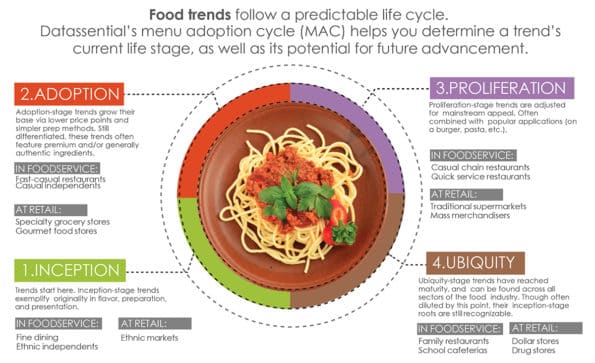Food trend: Taking the pulse of non-meat proteins

Join Mark DiDomenico for “Trends and Predictions in Foodservice 2016 – Supermarket and Convenience Stores” at Supermarket Sense 2016, Sept. 21-22 in Conyers, Georgia.
Proteins have been on consumers’ (and food service operators’) minds for the past few years. The trend has shifted to “ubiquity” on the adoption cycle used by our food industry research firm, Datassential (see graphic). But there is a sub-trend gaining traction; increasingly, people are looking to non-meat sources to provide protein.
In fact, the United Nations declared 2016 the year of the “pulse,” in an effort to promote the benefits of non-meat proteins. I’ll talk more on what all the buzz about pulses means to food retailers at the upcoming Supermarket Sense event Sept. 21-22, taking place just outside Atlanta. But let’s start here with a short primer. Just what are pulses? The U.N.’s Food and Agriculture Organization defines them as leguminous crops that yield grains or seeds and can be dried and stored. Think lentils, beans, peas and chickpeas—all critical non-meat protein sources in any food basket.
The U.N. likes pulses on a global scale because they pack a lot of nutritional punch, and they cost less and use fewer resources than raising livestock for meat. But even in countries like the United States, where people may have the household budgets to splurge on steak, pulses are gaining popularity as part of the healthy-eating trend. That’s largely because a pulse is a twofer food. It provides both the protein and the fiber that health-conscious eaters crave. As a bonus, pulses offer amino acids and other nutrients, and they’re filling but aren’t loaded with calories.
So, what’s our strategic advice for food retails? First, pay attention. Are you seeing a bump in center-store sales of beans, chickpeas and other pulses? If so, encourage more of those sales with merchandising that educates consumers about the health benefits of pulses.
Second, integrate pulses into your menu for hot and cold prepared foods. The business case is good: These ingredients will cost you less than meat, and busy, higher-dollar, health-conscious consumers who are your target shopper for prepared foods will pay a premium for pulses. Again, use educational merchandising to ensure shoppers understand the health benefits of what you’re selling.
We’ll talk more about the business potential for pulses at Supermarket Sense. I look forward to seeing you there.